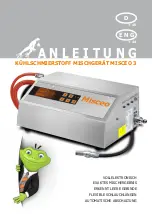
2
008175_i_--_--
en
Installation
Intended use
The input module monitors statuses of potential-free
contacts. A housing is available to protect the module
from environmental influences.
Installing the input module
The input module can be installed as follows:
–
In housing FDCH221 (Fig. 5)
–
On a top hat rail (Fig. 1)
–
On a plane surface (Fig. 2)
Installation in housing
NOTICE
Module use in a damp, wet or dusty
environment
Damage to module from dust or jet of water
·
In damp, wet or dusty environments, fit the
module in a housing FDCH221.
1.
Open housing (Fig. 5).
2.
Determine cable entries in housing and break them
open.
3.
Use two screws to fit the housing on a plane surface
(Fig. 3).
4.
Secure the M20 x 1.5 cable glands on the housing and
guide in the cables (Fig. 4).
5.
Use two M3 x 12 screws to fit the module in the housing
(Fig. 2).
6.
Close housing using supplied screws (Fig. 5).
Install input module on a top hat rail
NOTICE
High temperatures in the module's
environment
Module overheating and damage
·
A minimum clearance of 1 cm must be
observed between two modules or between
the module and any other boundary.
1.
Insert two mounting feet into the input module.
2.
Push the input module with the mounting feet against
the top hat rail until the mounting feet engage (Fig. 1).
Install input module on a plane surface
NOTICE
High temperatures in the module's
environment
Module overheating and damage
·
A minimum clearance of 1 cm must be
observed between two modules or between
the module and any other boundary.
1.
Secure input module with two screws on a plane
surface (Fig. 2).
Electrical connection
1.
Connect the cables to the terminals (Fig. 6).
Note the positive and negative poles.
Only connect one wire per terminal. This is the
only way of ensuring a problem-free connection
over the device's entire service life.
2.
If using shielded cables:
Use auxiliary terminals DBZ1190-AB (accessories) and
connect shielding to auxiliary terminals. The shielding
must not touch any extrinsic potentials to ground or
metal parts in the device.
3.
Connect resistors to input terminals according to
planning:
–
Rp 3K01 line resistor
–
Rs 1K15 series resistor
The resistors must be connected at the end of the line!
4.
Secure cables on module with cable ties.
For more information see document 007023.


























